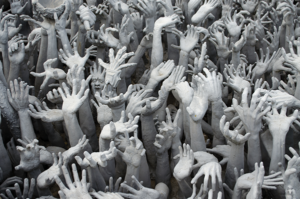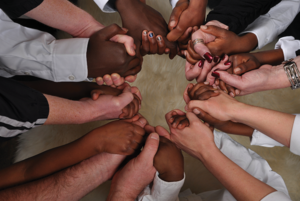Can Bacteria Help Us Understand Religion?

RELIGION IS one of the most powerful forces in human society. Before the rise of the Christian Right in the United States and before Islamists turned planes into bombs and started beheading people on social media, many Americans thought of religion as a relatively benign institution or, at worst, one that was toothless and doddering. Sure, religion may once have had the power to burn libraries and infidels or rouse armies of crusaders, but that all seemed like distant history. In modern popular vernacular, “that’s not very Christian of you” simply meant not very nice, and Islam was said to mean peace rather than its other root: submission.
But as a psychologist and former fundamentalist, I have always had a healthy regard for the power of religious belief.
During my years as an evangelical Christian, I heard the story of Nicky Cruz, a New York gang member whose life had been transformed by Jesus; the story of Chicago’s Union Gospel Mission that turned alcoholic bums into sober Christians; and the story of missionary Elizabeth Elliot who dedicated her life to saving the souls of Amazonian headhunters after they killed her husband.
 After I left Christianity, I heard stories of lives transformed in bad ways by religious belief—adults plagued by panic attacks from childhood threats of hell; families torn apart when one member restructured his or her life around religious scripts or, alternately, de-converted and was disowned; and devout parents who followed the Bible’s advice (“beat your son with a rod“) to the point that they killed their children. I read letters from missionary believers who fantasized torture and death for anyone who blocked them from seeking converts on, say, public school grounds or military bases. “I will pray The Word that our righteous Lord and Savior will smite you,” they’d write. “First on the list: pray the Lord to have Mr. Weinstein watch Mrs. Weinstein burn alive in a car accident.”
After I left Christianity, I heard stories of lives transformed in bad ways by religious belief—adults plagued by panic attacks from childhood threats of hell; families torn apart when one member restructured his or her life around religious scripts or, alternately, de-converted and was disowned; and devout parents who followed the Bible’s advice (“beat your son with a rod“) to the point that they killed their children. I read letters from missionary believers who fantasized torture and death for anyone who blocked them from seeking converts on, say, public school grounds or military bases. “I will pray The Word that our righteous Lord and Savior will smite you,” they’d write. “First on the list: pray the Lord to have Mr. Weinstein watch Mrs. Weinstein burn alive in a car accident.”
Religion, like almost no other human enterprise, arouses a surprising percentage of people to such heights of passion that they abandon all else and devote themselves to the propagation of religion itself—even when that means giving up their own life or taking the life of another. Even more moderate belief can drive people to do things that range from shockingly altruistic, like taking in a homeless stranger, to shockingly cruel, like throwing their queer child out onto the streets. (These actions can also be shockingly at odds with that person’s character.)
Some Christians say that we humans are, all of us, “utterly depraved” and that without religion—or rather Christianity specifically—the world would descend into End Times anarchy. Outsiders sometimes argue the opposite, that religious belief prompts fundamentally decent people to do horrid things they wouldn’t do otherwise. Physicist (and 2002 Humanist of the Year) Steven Weinberg put it this way: “With or without religion, you would have good people doing good things and evil people doing evil things. But for good people to do evil things, that takes religion.”
“Is it a mental illness?” Because I am a psychologist, people sometimes ask me, quite seriously, whether religion—or at least religious fundamentalism—is a psychopathology. After all, most religions seem somewhat crazy from the outside. If someone were alone in believing that his child was going to be tortured forever unless they prayed a certain prayer—or if someone were alone in believing that a supernatural being cares whether you wash plates that have touched milk and those that have touched meat in the same dishwasher—or if someone were alone in believing that God wanted all women to walk around in black sacks with their faces covered—we might suspect that person was schizophrenic. But schizophrenia is caused by a breakdown of neurological systems within the individual, and religion is not.
Religious beliefs, however incredible they may be to outsiders, are held by millions of people who find their own bizarre convictions intuitively resonant and perfectly reasonable—and who are otherwise quite sane. Also, peculiarities aside, religions seem to bring out the best in some people, perhaps by enhancing altruism or providing community support for acts of generosity and compassion, or by disinhibiting wonder and joy. So, for years I said no, not a psychopathology.
But some similarities nagged at me. Take paranoid schizophrenia for example. Whatever the precise biological mechanisms may be, the person has a set of peculiar and powerful experiences that the mind seeks to explain. Over time, a whole plotline gets fabricated, with actors and motives and perceived relations between events that become self-confirming and utterly impervious to rational disconfirmation. Any attempt to challenge the story provides further proof that it is true.
Schizophrenic delusions tend to have some special features that are a consequence of how schizophrenia itself works (the person’s beliefs need to account for experiences like visual hallucinations, thought insertion, or hearing voices). But otherwise, the end product is not unlike many widely held conspiracy theories and some forms of religious belief. The primary difference between a schizophrenic’s delusional system and a conspiracy theory or system of fundamentalist theology is that in schizophrenia the plot structure is triggered by a biological malfunction, is idiosyncratic (meaning that despite common themes it differs from person to person), and lacks social validation.
So, the causes are different, but the products are oddly similar; and over the years, the more I thought about it, the more I came to wonder if religious belief might be best construed not as psychopathology but as something related that I called a socio-pathology. By this I meant a delusional system that has its root not in a biological malfunction but rather in a malfunction of social information flow.
I now think that hunch was only partly right. To explain, I need to delve into the nature of the human mind, the nature of ideas, and the nature of religion—with a little help from bacteria.
Why We Pass on False Ideas
Accurate information has survival value. Human beings, for the most part, are deeply invested in knowing what is real, and we have evolved all sorts of mechanisms for discerning deception, error, and other forms of falsehood. For example, we read eye contact and body language, and we often have an intuitive suspicion of things that sound “too good to be true.” Once we get fooled by someone, we are wary thereafter; and rebuilding trust can be challenging. Fool me once, shame on you; fool me twice, shame on me, as the saying goes. Across both secular and religious wisdom traditions, lists of virtues include words like honesty, integrity, skepticism, veracity, and trustworthiness. Religions (and political parties) proclaim themselves sole purveyors of truth, often written with a capital “T.”
This isn’t to say that honesty always rules. People deceive each other for countless reasons, and some take particular pleasure in getting away with it—magicians, for example, or on a darker note, sociopaths. But even among people who are perfectly ordinary and morally intact, white lies are ubiquitous and black lies common. (Evolution likely primed us for some optimal balance between being deceitful and being perceived as trustworthy.)
Also we don’t just trick others. Healthy adults indulge some virtually universal and likely adaptive patterns of self-deceit—thinking, for example, that we are more competent and better liked than is actually the case. We regularly fall into biases called confirmatory thinking and motivated reasoning, and, in fact, human knowledge exploded only after we figured out a system for erecting barriers against these biases. We call that system the scientific method, and it is basically a procedure for forcing ourselves to ask the questions that could show us wrong.
But regardless of humanity’s self-serving penchant for fudging the facts, being able to figure out what’s real has tremendous survival value, and so we care about it—a lot.
Information gets passed through hierarchical social networks. We also love sharing information. When my brother David was three, he learned how to pee standing up. He was so excited, that the next time he saw sister Kathy, age twenty, heading for the bathroom, he ran after her to share his newfound knowledge. But for some reason unbeknown to him, he failed to convince her that she could do it too. After trying several times to explain, he got so frustrated that he burst into tears.
 Some scientists describe our species as “social information specialists.” That is our ecological niche. This means that we are social animals, and the way that we survive and thrive is by gathering information, which we mostly get from other human beings. We transfer information vertically from generation to generation and horizontally between members of a generation.
Some scientists describe our species as “social information specialists.” That is our ecological niche. This means that we are social animals, and the way that we survive and thrive is by gathering information, which we mostly get from other human beings. We transfer information vertically from generation to generation and horizontally between members of a generation.
We are also a hierarchical species, which is relevant to information flow in a couple of ways: people gain status by having valuable information to share, and we look to those who have more power and status than us—in other words authority figures—to provide us with particularly valuable information.
This whole system of trading information exists to help us survive and thrive, largely by making it possible for us to assess the contingencies that govern our wellbeing and then act accordingly. Information we get from other people lets us know which buttons to push and levers to pull without having to try them all out—so long as what we learn from others actually maps to reality. Consequently, our ability to discern what is real is pretty good.
But it’s far from perfect.
We share patterns of blind spots. Most people have heard that our eyes don’t bother scanning everything in our environment. Rather, we scan for certain features and then literally fill in the blank spots by hallucinating. This works better than mapping every detail because it is so much faster and more efficient, and also, our optic nerves or external objects can obstruct part of our visual field.
 But our eyes and visual cortex aren’t the only part of us that relies on shortcuts. Behavioral economist Daniel Kahneman won a Nobel Prize for his research on the fact that our brains have two different processing modalities, which he calls thinking fast and slow.
But our eyes and visual cortex aren’t the only part of us that relies on shortcuts. Behavioral economist Daniel Kahneman won a Nobel Prize for his research on the fact that our brains have two different processing modalities, which he calls thinking fast and slow.
Thinking slow is the conscious reasoning that we like to think underpins most of our decisions. In reality, much of what we believe and do gets decided by thinking fast—a kind of information processing that is quick and intuitive, largely subconscious, and prone to specific kinds of glitches. Even the most vigilant truth-seeker engages in laborious conscious analysis a minority of the time, when incoming information gets flagged for extra scrutiny—perhaps because it is counterintuitive or emotionally displeasing, or because it comes from someone we mistrust.
Our blind spots and shortcuts, some of them hard-wired and some formed of habit, create opportunities for misinformation to slip past our defenses. False ideas can feel true when they are not. They can avoid detection and correction, and get passed from person to person and generation to generation. And that, in an odd way, is by design.
Ideas as Virus Self-Replicators
Ideas have a life of their own. Just as planet Earth is host to millions of species in an intricate web that we call the biosphere, it is possible to think of an ideosphere: a web of ideas as intricate and diverse as the web of life. These ideas evolve and reproduce not on a planet, but in the fertile world of conscious minds. Much like living organisms, they can be thought of as discrete entities, as self-replicators that have an existence all their own.
No analogy fits perfectly, but when it comes to the relationship with between us, as human hosts, and our ideas, it may be easiest to compare ideas to microbes, specifically those that live on or in other organisms. Like the microbes we carry around, ideas are contagious—some more than others. They get transmitted from one person to another through our contacts and communities. Scholars can trace the spread of a contagious idea—a new slang word like “woke” or a fashion fad like saggy pants—the way that epidemiologists trace the spread of a disease.
Also like micro-organisms, ideas are subject to natural selection—selective pressures that cause them to flourish or evolve or to die out altogether independent of whether their hosts live or die.
In his book, The Selfish Gene, Richard Dawkins coined the term “meme” to describe a unit of information that can get passed from person to person (transmitted from host to host), evolving over time. Dawkins and other scientists of his generation had come to recognize that natural selection operates on a variety of media, not just DNA. In fact, it can operate in any medium in which information has the opportunity to replicate and mutate and then get passed on or not—including silicon (think computer viruses) or the interconnected network of human minds, the ideosphere.
In Dawkins’ framework, individual religious dogmas can be thought of as memes, while whole religious ideologies, which comprise sets of ideas that are bound together and tend to travel in tandem are called “meme complexes.” Academic psychologist and biologist Susan Blackmore has built on Dawkins’ work to further clarify what memes are and how they function.
The phrase that Dawkins used in his title, the selfish gene, refers to the fact that—to put it in wildly anthropomorphic terms—a gene doesn’t give a damn if you survive, so long as it does. In evolutionary terms, it’s fine for the male black widow to get eaten after mating, because that helps his genes get passed on. By analogy, an idea may kill its human host (think Jihadis and martyrdom) so long as that helps the idea spread.
We humans have a cognitive immune system. Come back now to the fact that knowing what is true helps human beings survive. False memes, like the promise of seventy-two virgins for a Muslim martyr, may be indifferent to our survival, but we are not. Consequently, we have evolved sophisticated mental defenses that detect and correct misinformation. Our finely-tuned bullshit detectors react to false ideas in much the same way that our immune system reacts to parasitic bacteria, viruses, prions, and fungi that have adapted to live in and on our bodies—by identifying potential harms and eliminating them.
 But as we all know, immune systems are far from perfect. Pathogens evolve a variety of successful strategies to get around human immune defenses and then trigger us to do things that pass on their genes to other people—sneeze, for example. Some pathogens—like influenza —mutate rapidly, so that old antibodies won’t work. Others, like Herpes simplex, hide in places our immune system can’t reach and then emerge from time to time in order to get spread. Still others, like MRSA, develop into mutant “superbugs” that withstand treatments that would have wiped out their ancestors. In his 2001 book, Parasite Rex, Carl Zimmer described the fascinating arms race between biological hosts like human beings and parasitic organisms.
But as we all know, immune systems are far from perfect. Pathogens evolve a variety of successful strategies to get around human immune defenses and then trigger us to do things that pass on their genes to other people—sneeze, for example. Some pathogens—like influenza —mutate rapidly, so that old antibodies won’t work. Others, like Herpes simplex, hide in places our immune system can’t reach and then emerge from time to time in order to get spread. Still others, like MRSA, develop into mutant “superbugs” that withstand treatments that would have wiped out their ancestors. In his 2001 book, Parasite Rex, Carl Zimmer described the fascinating arms race between biological hosts like human beings and parasitic organisms.
Like our biological immune systems, our psychological immune systems—what I called bullshit detectors—are far from perfect. And like microbes, false viral ideas may have a variety of successful strategies for getting passed on. They may seem intuitively reasonable, or may create a sense of knowing pleasure. They may mimic ideas that are indisputably real, for example: “I have a biological father, why not a father in heaven?” Some memes, like chain mail, even have an explicit “copy me” command: “If you care at all about people with cancer, hit share” or, “Go into the world and make disciples of every creature.”
So, let’s put this all together: As viral self-replicators, ideas have a life of their own. Human beings have a cognitive immune system that seeks to identify and eradicate false ideas because misinformation tends to cause us trouble. Some false ideas evade our bullshit detectors and so get passed socially from person to person. In this context, when religious notions take root in human minds and get passed on despite containing maladaptive falsehoods that do us harm, they may be considered socially transmitted pathologies or, to use my earlier term, socio-pathologies.
But there’s a catch.
Parasite or Symbiote?
Here’s the reason this way of construing religion doesn’t quite work: The term pathology implies illness and disability—but not all forms of religion seem to cause harm.
This appears to be the case irrespective of their truth value. All of the world’s great religions fail the “outsider test of faith,” meaning they fail to meet any normal bar for credibility when scrutinized by an outsider applying the same rigorous standard of evidence to each. In their traditional forms, all contain rational and moral contradictions or factual inaccuracies that insiders can justify only with Olympic feats of mental and moral gymnastics. Many rely on sacred texts that reflect the precise combination of knowledge and ignorance that characterized the culture in which they were written. All make claims for which there is no proof and none possible.
Even so, the harms done by religions vary, and in fact under the right combination of context, person, and belief, religious practices appear to have benefits for individual practitioners and their communities if not our world. For example, it helps people cope with disasters and increases prosocial behavior toward insiders. It’s entirely possible that most or all religions were adaptive in their original form at the place they emerged, helping believers to outcompete nonbelievers or helping one tribe to outcompete another. Susan Blackmore argues that from a strictly evolutionary standpoint religions are adaptive today in that religiosity increases the birthrate for adherents, especially those who are most devout.
If that sounds noxious, we must remember that today’s context—with competing religious tribes wielding weapons of mass destruction on a global scale and promoting competitive breeding while humanity faces potential collapse —is a historical anomaly. Nobody really knows whether religion taken as a whole has done humanity more harm or more good, but either way, research suggests that religion helps at least some people some of the time.
At worst, then, religion produces some combination of harms and benefits, which tends not to be the case for pathogens. If religion sometimes helps people to survive and thrive and produce more offspring; or psychologically, if some religious fictions might be considered adaptive fictions—it’s easy to imagine, for example, that believing God loves me might aid depression or confer resilience—then religion as a whole can’t really be considered a socio-pathology.
That doesn’t mean the pathogen analogy fails altogether. It may still be useful to think of religion as a socially-transmitted infection—or better yet, to think of religions (plural) as a family of socially-transmitted infections, only some of which are pathological.
Not all socially-transmitted infections are unhealthy. Viruses that infect humans are almost universally harmful, but the same isn’t necessarily the case for other microscopic self-replicators, like bacteria, which may provide a better analogy to religion.
Human beings play host to a wide variety of bacteria. Estimates suggest that 500 to 1000 different types live in our mouth and gut alone. These organisms exist as independent self-replicators, meaning that whatever they do is designed to promote their own ability to live and reproduce, not ours. As I said earlier, so long as they can spread little copies of their own DNA, bacteria are utterly indifferent to their impact on our wellbeing.
Our relationship with any given type of bacterium may be symbiotic, meaning a mutually beneficial arrangement in which we help each other survive—like the little guys that live in our gut and eat our food waste. Alternately, the relationship may be adversarial—as in the parasitic bacteria that begin to eat our muscle tissue when we get a cut and must be killed off by antibodies or antibiotics to prevent sepsis. Some organisms may be perfectly capable of playing either role—eating either our waste or our bodies, depending on the circumstances.
The spectrum of relationships we have with the self-replicating bacteria we host may offer some insight into our relationship with the self-replicating religious ideas that we also host.
Religions have many shapes. Religions don’t vary as much as micro-organisms, but they do vary dramatically, because they are constantly evolving. Since its founding, Christianity alone has branched into more than 30,000 different denominations and non-denominations, each persuaded that their understanding of God is slightly or substantially more true than the rest.
 Outside of Christianity, most people today ascribe to one of ten or so major religions: Shinto, Islam, Hinduism, Buddhism, Judaism, Taoism, Confucianism, Jainism, Sikhism, and perhaps Zoroastrianism. That said, each of these might better be thought of as a family of religions, much the way that influenza should really be thought of as a family of related viruses: bird flu, swine flu, 1918 epidemic flu, seasonal Type A flu, and so forth.
Outside of Christianity, most people today ascribe to one of ten or so major religions: Shinto, Islam, Hinduism, Buddhism, Judaism, Taoism, Confucianism, Jainism, Sikhism, and perhaps Zoroastrianism. That said, each of these might better be thought of as a family of religions, much the way that influenza should really be thought of as a family of related viruses: bird flu, swine flu, 1918 epidemic flu, seasonal Type A flu, and so forth.
Outside of these major families of religions lie many others: indigenous religions, for example, and new religious movements. And this doesn’t count the thousands of religions that once lived in human minds but have now gone extinct.
All of this variability creates a lot of space for the possibility that some religious memes are symbiotic and others parasitic—and that the package of ideas espoused by any given church or individual might include some of both. Asking whether religion broadly is harmful or beneficial may be as silly as asking the same question about bacteria. It just is, whether we like it or not.
And yet we know beyond a shadow of a doubt that some religions are doing tremendous harm in our world, to the degree that religion’s mutually exclusive truth claims and tendency to promote tribalism may put humanity’s future in jeopardy. At the individual level, religious beliefs and edicts are causing immeasurable suffering in the lives of individual people around the world, disproportionately affecting the most vulnerable among us—women, children, the desperate, and the poor. If we want to move toward a better future, we cannot escape the task of addressing religious harms.
Challenges for the Future
Scholars have only recently begun studying religion as a natural phenomenon, applying standard methods in sociology, psychology, anthropology, and neurology to answer questions about what religion is and how it gets transmitted. An economist now may analyze a religion as an economic system in which adherents trade present time and resources for afterlife goods and services. A political scientist may analyze it as a set of social institutions that create order and group identity. A historian of science may examine it as a system of proto-science that once provided explanations for natural phenomena and events.
Among all of these fields of study, the scholarship that most transforms our understanding of religion may come from the burgeoning field of neuroscience. The answers aren’t all in, but if you want a teaser, Pascal Boyer (Religion Explained) examines how religion fits the structure of human information processing. Psychiatrist Andy Thomson (Why We Believe in Gods) has described how religion taps normal mechanisms of child development and attachment. Neurologist Robert Burton (On Being Certain) discusses in lay terms why people so often feel utterly convinced that something is true when it isn’t.
To date, although we now have access to impressive diagrams of religion’s evolutionary history and family tree, little research exists on the viral transmission and evolution of religious ideas:
- What makes some religions so compelling that people risk their lives in the Amazon jungle, or stand preaching on street corners, or maneuver their way into public grade schools, or even wage Jihad to spread their beliefs?
- How does religion prompt people to do things they otherwise would find odious or immoral?
- What kinds of ideas are most “sticky” and likely to get passed on?
- Why are some particularly robust in the face of contradictory evidence?
- What is the process by which once-unassailable beliefs crumble?
Can we consciously evolve humanity’s religious enterprise to reduce harms while keeping benefits?
The answers lie somewhere in the shape of the human mind and the complementary shape of viral ideas that take up residence there. But to answer broad questions like these, we probably will need to break them into smaller ones like: Under what circumstances? For whom? To what degree?
Interestingly, the word pathological itself offers at least one clue about where we might direct inquiry about religious harms. Pathological has two meanings. The first relates to disease or ill health. But the second focuses on obsession and compulsion, as in “a pathological liar.” Perhaps the level of socio-pathology caused by a religious meme or meme complex depends, at least in part, on the degree to which it leverages compulsion as part of its reproductive strategy. Religious compulsion might refer to the level of threat and fear a religion uses to win and keep converts, or the degree of obsessive thought and compulsive behavior it engenders in believers.
But compulsion is likely to be just one part of the picture, because the experience of many religious believers is that they practice their faith freely and happily—even when this may seem dubious to outsiders. The answers, in other words, won’t be simple.
Reaching the point that we understand religion well enough to head off some of its worst manifestations may be a daunting challenge. But given our interconnected world and enormous destructive capacity, it is a challenge we can ill afford to ignore.
